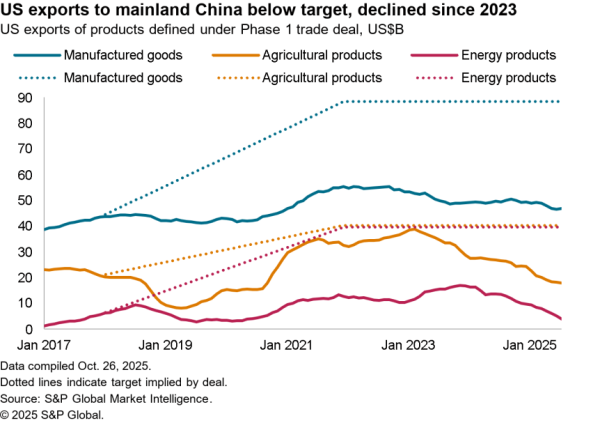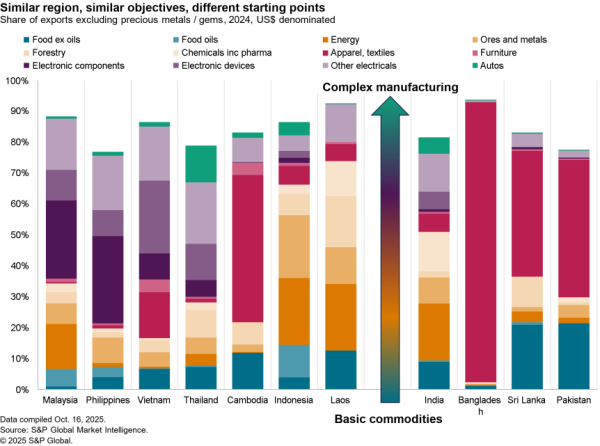The COVID-19 pandemic, along with several other factors, has helped increase supply chain demand and congestion. As major nodes in downstream supply chain operations, seaports have the potential to ease those troubles if they can improve their operational efficiency. Digital transformation and IoT projects at ports have the potential to assist in improving their operations. This report brings together analyses from S&P Global Market Intelligence’s 451 Research (Mark Fontecchio) and Panjiva Research (Chris Rogers, Eric Oak) groups.
The 451/Panjiva Take
Effective supply chain management is a key to corporate success, and has become exponentially more difficult in the wake of COVID-19. Demand for shipping services is at a historic high, and has coincided with historic underinvestment in logistics infrastructure and systems, resulting in disruptions that are set to continue into 2022. Given the importance of their supply chains, companies of all types are collecting more data from more sources. As a result, supply chain and logistics applications are now the second-most popular IoT solution. With no end in sight for supply chain demand, ports are taking steps toward digital transformation to improve their operations. Some IoT projects can help with short-term improvements in throughput, but long-term investments in port upgrades via capital expenditure have been more difficult to come by.
The never-ending peak season
Supply chain management has always been central to corporate success. This was brought to the fore during the pandemic as companies struggled to meet demand in the face of a constrained logistics industry and rapidly rising rates. Systemic undersupply of capacity was joined by a series of unfortunate events, documented extensively in Panjiva’s research, including the Suez Canal blockage; the closure of port activities at Yantian due to staff shortages; a spate of containers lost overboard in heavy seas; vessel fires linked to engine failures; and a range of IT challenges, including a cybersecurity breach at Transnet and a systems failure at Port Houston.
The pressure will likely not be alleviated in the near term. Notably, the absence of an off-peak season is evident – US seaborne imports remain elevated, with growth of 34.9% year over year in Q2’21 and 19.9% compared with Q2’19, according to Panjiva‘s data.
Compounding this, logistics operators – ranging from freight forwarders such as DSV Panalpina, K+N and C.H. Robinson to port operators like the Georgia Ports Authority – highlight the likelihood that a normalization of logistics networks is unlikely until Q2’22 at the earliest.

Source: Panjiva
Connectivity rising in transportation, logistics
As the importance of the supply chain came into sharper focus over the last 18 months, organizations took technological steps to improve visibility and optimize their own supply chains.
Optimizing requires analyzing, which requires measuring key performance indicators in the supply chain. Measuring KPIs necessitates connectivity and data in the right locations to gather the right information. That’s exactly what organizations have done. As seen in Figure 2, more organizations are gathering data from fleet vehicles and supply chain devices, according to 451 Research’s Voice of the Enterprise surveys. The change is even more apparent when transportation companies are examined. Fewer than one-third of them collected data from their supply chain devices at the start of 2020. That increased to more than half by the start of this year.

The question then becomes: What are they doing with all of those newly connected endpoints? Among all organizations, supply chain and logistics applications are second only to data management in terms of the types of applications that are using connected endpoints. Within the transportation and public sectors, we see some specific use cases that apply to seaport modernization, according to our Voice of the Enterprise: IoT, The OT Perspective, Technology & Vendor Decisions 2021. Many are currently in use, presenting opportunities for ports to become more operationally and environmentally efficient.

The transportation and public sectors have historically been slow to adopt new technologies. IoT is no exception. At 451 Research, our enterprise survey tracks IoT adoption for six verticals: transportation, government, manufacturing, utilities, healthcare, and oil and gas. Of those, transportation and government have the lowest share of companies with IoT projects in place. The flipside is the potential – those two same verticals have the highest percentages of organizations planning to implement IoT in the next two years. The takeaway here is that the transportation and public sectors are behind the curve on IoT adoption, but on the cusp of larger levels of digital transformation, and that includes ports.
Potential for investment
Investment in the maritime sector has thus far focused on building new shipping vessels to meet rising demand and the need to improve the environmental aspects of shipping. The latter has been accelerated by the arrival of the EU’s ‘Fit for 55’ package, which will include shipping in the EU carbon-trading scheme, likely from 2026. As a consequence, orders for new shipping vessels at Chinese shipyards in H2’21 reached their highest levels since 2014.
There has also been increasing investment in digital freight forwarding and pricing platforms, bringing total financial investment in the logistics sector to over $11 billion in Q2’21, the highest in at least five years.
Investments in and by ports, meanwhile, has lagged, partly reflecting the multiyear nature of traditional port investment programs, such as new terminals, dredging and crane systems. The latter have been picking up, with lift system Cargotec reporting record new orders in Q2’21.
Deliveries into US ports associated with Cargotec and erstwhile merger partner Konecranes have yet to recover to levels seen before the pandemic, with shipments linked to Cargotec down by 10.1% in Q2’21 versus Q2’19, while those linked to Konecranes are unchanged.

Source: Panjiva
Short-term digital transformation opportunities
Managing cargo throughput in the near term is top of mind for most port operators. For many, real estate expansion isn’t feasible in the near term; neither are large infrastructure-intensive projects, such as deploying automated gantry cranes. Thus, they must work to manage an increase in twenty-foot equivalent units (TEUs) despite static levels of waterfront space and cargo terminals.
An upgrade or improvement to its terminal operating system (TOS) software can help a port handle some of that extra throughput. Players in this space include Navis and CommTrac. When combined with the right IoT deployment – for example, vessel tracking and traffic control – optimization of the TOS can increase a port’s throughput.
There is traction among some relevant IoT projects in transportation and government. Four out of 10 maritime companies say they have deployed fleet tracking, or plan to within two years, according to our enterprise surveys. Meanwhile, one-third of government organizations we polled say they have deployed traffic-control IoT projects, or will within two years. Video surveillance, the most popular IoT use case among government organizations, with nearly half having it deployed today, can also be used to analyze traffic patterns at seaports. Finally, more than one-third of governments have environmental monitoring in place, or will within two years.
All of the above can be combined to provide insight into when vessels are planning to arrive at port and how efficient the unloading and loading of cargo is at berth. The Port of Rotterdam, one of the busiest in Europe with some 28,000 seagoing vessels and 93,000 inland vessels in 2020, considers digitalization to be a fifth modality alongside water, roads, rail and pipelines. The port authority has undergone a multiyear process to handle more shipments in the same geographic footprint. Doing so has meant deploying IoT and digital transformation projects to operate more efficiently. For example, it connected various environmental and visual sensors around the port to provide help in planning and guiding vessels into the port. Optimizing route planning may take the form of telling a vessel to slow its approach to the port if congestion is high or the tide is too low, managing congestion before it reaches the port.
Longer term: Automation and port expansion
Among maritime companies, three out of five say they have autonomy deployed, or plan to within two years. That may be an overly optimistic outlook, but it emphasizes the desire of these companies to move in that direction.
Automation in container terminals isn’t anything new, but adoption has been spotty. Automated equipment to handle containers at ports has been around for close to three decades and includes container stacking cranes (ASCs) and automated guided vehicles. ASCs can place containers on AGVs, which are equipped with sensors like wheel encoders and radars to follow a predetermined path and bring a container to where it needs to go, such as a container yard or intermodal terminals for road or rail. In 2017, the Port of Shanghai opened an automated container terminal called the Yangshan Port that largely does this – dozens of bridge and gantry cranes, along with AGVs, controlled by software instead of humans.
Adoption of automation can sometimes run into nontechnical blockades. For example, the International Longshore and Warehouse Union opposed recent automation at the Port of Long Beach in southern California, on the grounds that it could eliminate jobs. Maritime companies and associations reply that automation simply allows seaports to manage more cargo throughput with existing staff. Negotiations sometimes lead to partial automation as a stepping stone.
In the meantime, the pain for port operations can be substantial. There may be little appetite among port authorities for further reliability reductions, given they are only just emerging from a period of intense disruption due to the pandemic. Shipments into the ports of Los Angeles and Long Beach suffered significant disruption in 2015 during an extended strike, and that was held during the Q1 off-peak season. Industrial action during peak season could be a major challenge for US supply chains on a broad basis.
Finally, private investment or strategic funding from the government may give seaports the opportunity to build new terminals that adopt some of these IoT projects, so that they are more efficient operationally and environmentally. The US Congress is currently negotiating a bill to provide close to one trillion dollars for infrastructure, with much of it going toward transportation infrastructure on roadways and rail, and in ports.
A main focus of the bill funding is to ‘build back better’ by developing and building infrastructure that is more efficient and limits carbon emissions. The desire to show rapid use of those funds may mitigate short-term investments over long-term, regulation-bound investments in new terminals. IoT projects such as vessel tracking, route optimization and autonomy can further those goals.

Source: Panjiva




